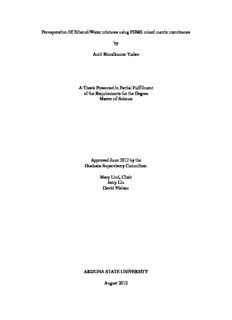
Pervaporation Of Ethanol/Water mixtures using PDMS mixed matrix membranes by Amit ... PDF
Preview Pervaporation Of Ethanol/Water mixtures using PDMS mixed matrix membranes by Amit ...
Pervaporation Of Ethanol/Water mixtures using PDMS mixed matrix membranes by Amit Binodkumar Yadav A Thesis Presented in Partial Fulfillment of the Requirements for the Degree Master of Science Approved June 2012 by the Graduate Supervisory Committee: Mary Lind, Chair Jerry Lin David Nielsen ARIZONA STATE UNIVERSITY August 2012 ABSTRACT Among the major applications of pervaporation membrane processes, organic separation from organic/water mixtures is becoming increasingly important. The polydimethylsiloxane (PDMS) is among the most interesting and promising membranes and has been extensively investigated. PDMS is an "organicelastomeric material, often referred to as "silicone rubber", exhibiting excellent film-forming ability, thermal stability, chemical and physiological inertness. In this thesis incorporation of nanosilicalite-1 particles into a PDMS matrix and effect of particle loading and temperature variation on membrane performance was studied. A strong influence of zeolite was found on the pervaporation of alcohol/water mixtures using filled PDMS membranes. The mixed matrix membrane showed high separation factor at higher zeolite loading and high flux at higher temperature. i DEDICATION To my family Binodkumar Yadav Geeta Yadav Anil Yadav ii ACKNOWLEDGMENTS I am sincerely grateful to my supervisor, Dr. Mary Laura Lind and co-advisor, Dr. Jerry Y.S. Lin, for their guidance, for all the things I have learnt from them and for the opportunity to work in their group. I would also like to thank Dr. David Nielsen for serving on my committee. I am also grateful to my current and former labmates with whom I had the pleasure to work: Shawn, Aditi, Kenji, Tianmiao, Carrie, Shriya, Matt, Tyler, Jose, Nick, Hiabing, Xiaoli, Alex, Defei and Bo. Thanks for your help, support and friendship. Special thanks to Xiaoli, and Fred Peña for their invaluable help and assistance that made possible the completion of this project. Finally I would like to finish by thanking my family. They have always supported and encouraged me to do the best in all areas of my life. They never let me down, and were a real support throughout all these years in school. iii TABLE OF CONTENTS Page LIST OF TABLES ..................................................................................................... vii LIST OF FIGURES .................................................................................................. viii LIST OF SYMBOLS / NOMENCLATURE ............................................................. x CHAPTER 1 INTRODUCTION .................................................................................. 1 1.1 Membrane Separation Processes .................................................. 1 1.1.1 Membrane materials for alcohol recovery ........................... 3 1.1.2 Membrane performance: Flux and Selectivity .................... 5 1.2 Zeolites .......................................................................................... 6 1.2.1 Definition, Structure and Applications ................................ 6 1.2.2 Transport through zeolite filled membranes ...................... 10 1.3 Mixed Matrix Membranes(MMM‟s) ......................................... 12 1.3.1 Background ......................................................................... 13 1.3.2 Factors affecting MMM‟s performance ............................. 13 1.3.3 Interface Morphologies ...................................................... 18 1.4 Pervaporation ............................................................................. 21 1.4.1 Introduction ......................................................................... 21 1.4.2 Thermodynamic Principles of Pervaporation .................... 22 1.4.3 Pervaporation Applications ................................................ 30 1.5 Research Objectives and Structure of Thesis ............................ 31 iv 2 FREE STANDING PDMS MEMBRANES FOR PERVAPORATION OF ETOH/WATER MIXTURE.................................................... 33 2.1 Introduction ................................................................................. 33 2.2 Pervaporation Setup .................................................................... 35 2.3 Experimental ............................................................................... 35 2.3.1 Equipments ......................................................................... 35 2.3.2 Free-standing Polydimethylsiloxane (PDMS) Membrane Preparation ........................................................................................ 37 2.3.3 Membrane Characterization ............................................... 39 2.4 Results and Discussion ............................................................... 40 2.4.1 Influence of feed concentration .......................................... 40 2.5 Conclusion .................................................................................. 42 3 SUPPORTED PDMS MEMBRANES FOR PREPARATION OF ETHANOL/WATER MIXTURE ................................................. 43 3.1 Introduction ................................................................................. 43 3.2 Dip-Coating ................................................................................ 46 3.3 Experimental ............................................................................... 47 3.3.1 Support Structure ................................................................ 47 3.2.2 Membrane Preparation ....................................................... 48 3.3.3 Membrane Characterization ............................................... 49 3.4 Results and Discussions ............................................................. 53 3.4.1 Effect of zeolite loading on EtOH/water permeabilities .. 53 v 3.4.2 Comparison with previously reported membranes ............ 55 3.4.3 Effect of temperature on pervaporation performance ....... 57 3.5 Conclusion .................................................................................. 59 4 SUMMARY AND RECOMMENDATIONS ..................................... 60 4.1 Summary ..................................................................................... 60 4.2 Recommendations ...................................................................... 61 REFERENCES ........................................................................................................ 62 APPENDIX A Preparation of Silicalite Sol .............................................................. 70 vi LIST OF TABLES Table Page 1. Dehydration of alcohols using different membrane materials .............. 4 2. Pervaporation of alcohols through hydrophobic membrane materials . 5 3. Ethanol/water separation factors for PDMS membranes .................... 34 4. Ethanol-water separation factors of silicalite-silicone rubber MMM‟s ....................................................................................................... …. 45 5. Permeabilities and Selectivities for membranes with different zeolite loadings at varying temperatures ....................................................... 55 6. Comparison of permeabilities and selectivities for some of the reported PDMS-zeolite membranes ................................................................. 56 vii LIST OF FIGURES Figure Page 1. Schematic representation of building units for zeolites ........................ 8 2. Structure of silicalite-1 .......................................................................... 9 3. Schematic of a mixed matrix membrane (MMM) .............................. 12 4. Development of the instability in films cast at elevated temperature . 16 5. Schematic diagram of various nanoscale morphology of the mixed matrix membrane ............................................................................... 19 6. Schematic of a pervaporation process ................................................. 22 7. Schematic of a pervaporation setup. Legend: 1-pervaporation cell; 2- membrane; 3-cold trap; 4-vacuum pump .......................................... 35 8. Cross-linking reaction of PDMS ......................................................... 38 9. ATR-FTIR spectrum of a free standing pure PDMS membrane ........ 39 10. Effect of feed concentration on PDMS membrane (100 micron thickness) ........................................................................................... 40 11. Images of straight pore alumina membrane. (a) Schematic of the straight pore structure and dimensions .............................................. 48 12. ATR-FTIR spectra of PDMS-zeolite composite membrane (MMM), PDMS coated anodisc, Nanosilicalite-1 zeolite partilcles and anodisc support. ............................................................................................... 50 13. SEM cross-sections of (a) pure PDMS membrane (b) 20 wt% nanosilicalite-PDMS membrane (c) nanosilicalite-1 particles. ........ 52 viii 14. Pervaporation tests of nanocomposite membranes at different temperatures (a) Flux (b) Separation factor (EtOH/Water) for 4wt% ethanol feed solution .......................................................................... 53 15. Apparent pathways of ethanol and water transport through a nanosilicalite filled MMM ................................................................. 54 16. Schematic of (a) densely packed polymer matrix chain matri at lower temperature (b) increased free volume due to polymer chain mobility and non-selective voids at polymer-zeolite interface occuring at higher temperatures ........................................................................... 59 ix
Description: